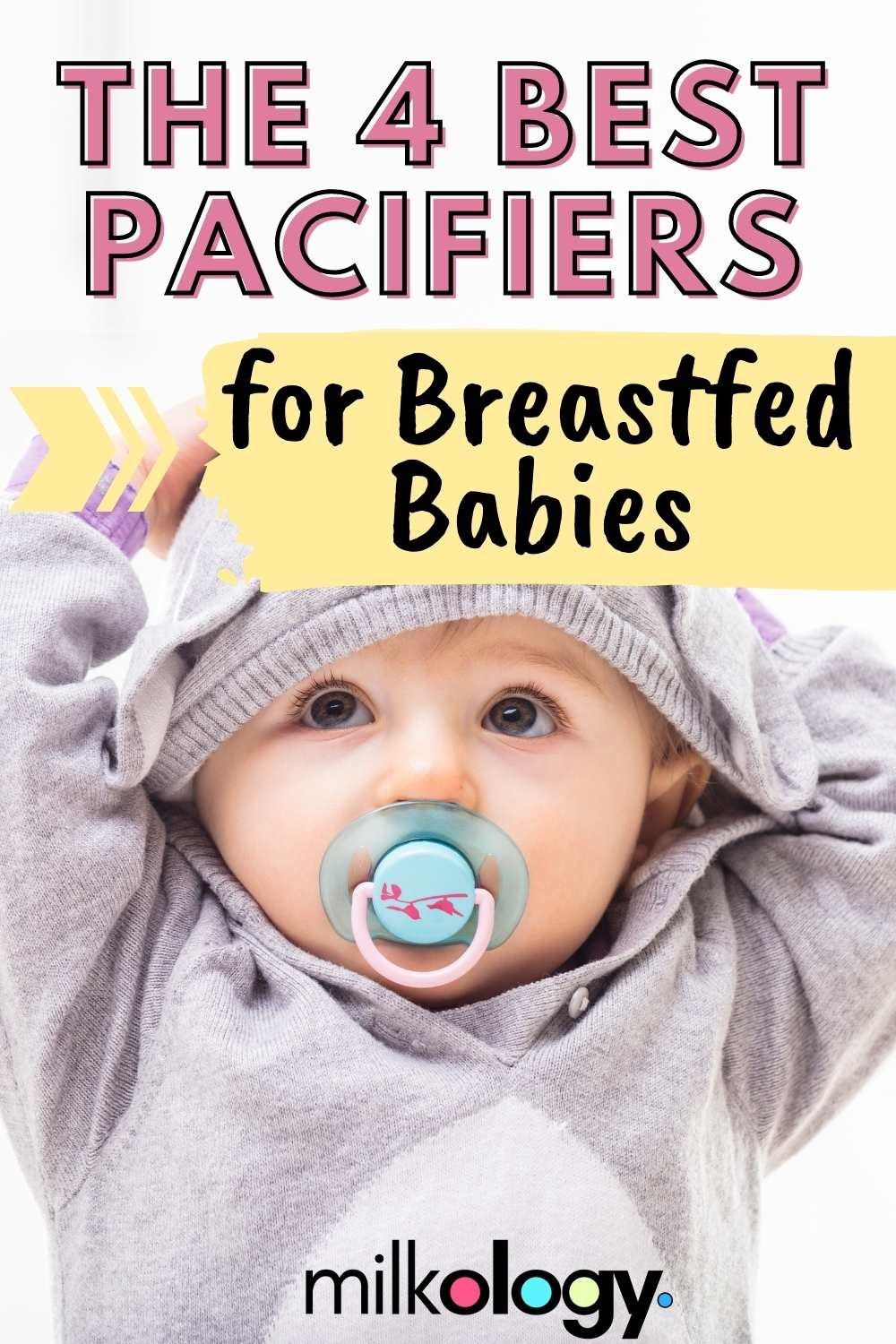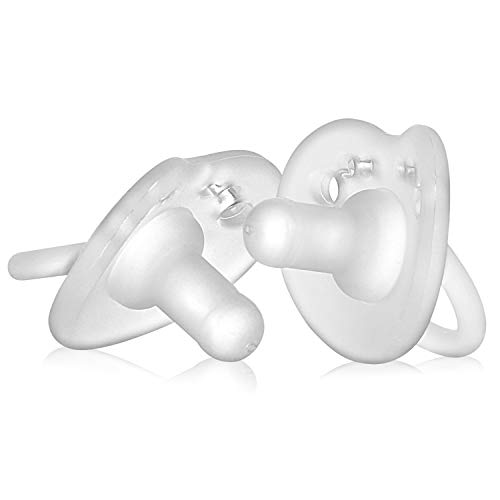Best Pacifier for Breastfed Babies (2025)
Binky. Soother. Paci. Dummy. Pacifier… Whatever you call them — if you’re a breastfeeding mama and want to give one to your baby, THIS is the article for you!
(this post may contain affiliate links)
Opinions on pacifiers vary, but one thing’s for sure - a pacifier can be a beneficial tool in certain situations. And they can get you out of a lot of jams as a parent! (specially when breastfeeding or bottle feeding isn’t an option at a particular moment)
Using pacifiers are great for…
Comforting NICU babies while they’re separated from their mothers.
Assisting tube-fed babies learn to use a bottle.
Helping you get a few hours of sleep in the middle of the night if you’re desperate and in crisis mode.
Enhancing oral motor function for babies with feeding issues.
Soothing a baby during a painful procedure. Babies feel less pain and are more relaxed when they’re sucking.
Reducing the risk of SIDS. Studies show that babies who use pacifiers while they’re sleeping are less likely to die from sudden infant death syndrome.
Calming a baby in the car. A pacifier may be the only way to keep them from screaming since you can’t breastfeed in the car.
Short on time and looking for the 4 best pacifiers for breastfed babies?
1. WINNER! Evenflo Feeding Balance Pacifier
2. Nanobebe Pacifier
3. Philips Avent Soothie
4. Ryan & Rose Cutie-Pat
Does a pacifier affect breastfeeding?
Long story short… it MAY.
Early pacifier use might interfere with breastfeeding.
If you introduce the pacifier too early it can mask important feeding cues and possibly reduce baby’s suckling at the breast. This may negatively impact your long term milk supply because you’re losing much-needed breast stimulation to the pacifier.
So it’s important to establish breastfeeding first before introducing a pacifier unless baby is sick or premature or has special circumstances.
Jennifer Horne, an IBCLC at The Lactation Network said, "It’s best to wait a few weeks until breastfeeding is going well before you introduce a pacifier to a baby." (The AAFP even suggests avoiding pacifiers for the first month.)
It’s a GREAT idea to take a simple and affordable breastfeeding class. Breastfeeding is something you need to LEARN to do. The Ultimate Breastfeeding Class is on-demand and perfect for new moms.
A pacifier may also affect the way a baby latches.
The shape and firmer feel of a pacifier differs from your pliable breast. This may lead to pacifier preference or confusion about how to latch onto the softer breast.
When should you introduce a pacifier to a breastfed baby?
Ideally wait to introduce a pacifier until breastfeeding is well established. If you’ve settled into breastfeeding, your baby is gaining weight consistently, and you’re about 6 weeks or more postpartum, you can introduce a pacifier if you’d like.
What to consider before introducing a pacifier to a breastfed baby
A number of studies show a connection between pacifier use and an increased number of ear infections.
Babies release sleepy hormones from sucking, whether they’re breastfeeding or using a pacifier, so pushing off a feeding by using a pacifier can alter feeding rhythms, decreasing the amount of feedings per day.
Pacifier use may cause baby to not eat often enough or get enough milk.
Any pacifier in the mouth affects oral development. Prolonged pacifier use (past 2 years old) may cause a child's teeth to be misaligned and not come in properly, or your child may develop speech problems.
Be Patient – Often breastfed babies refuse to suckle on pacifiers that just don’t feel right to them, which is why we are giving you 3 of the best pacifiers for breastfed babies!
The best pacifier for breastfed babies shape
The best pacifier shape for your breastfed baby is the one that has a cylindrical shape. Your nipple changes shape when your baby’s tongue wraps around it and the cylindrical shape allow the sides of the tongue to elevate and cup around the nipple, just like it does during breastfeeding.
So a cylindrical pacifier allows this same experience with your baby’s tongue as breastfeeding does.
TIPS FOR USING a PACIFIER WITH BREASTFEEDING
Choose silicone pacifiers as latex allergies in babies is on the rise.
Use pacifier in-between feedings and never use it to replace a feeding at the breast or use one to try to increase the length between feedings.
It’s best to use a straight pacifier, rather than a curved one.
Always rule out hunger as the cause of fussiness first. When a baby indicates a sucking need, it’s generally best that baby be encouraged to breastfeed first, especially if there is a weight gain concern.
Once baby has chosen their favorite pacifier, keep a few identical backups on hand.
Phase out using a pacifier towards the end of baby’s first year.
Choose the 1-piece, dishwasher-safe variety. Pacifiers made of two pieces pose a choking hazard if they break.
Don't use pacifiers with built-in gadgets, moving parts, or liquid interiors.
If your baby's not interested in the pacifier, don't force it.
Until your baby is 6 months old and their immune system matures a bit, clean the pacifier often by boiling it or running it through the dishwasher.
Replace often and look out for loose parts or signs of deterioration. Pacifiers can result in choking if the pacifier breaks.
Use the appropriate size for your baby’s age.
Use extreme caution with pacifier clips. Never attach a pacifier to a string or strap long enough to get caught around your baby's neck.
When to avoid or discontinue pacifier use
If pacifier use reduces your baby’s frequency or duration of feeds (newborns should breastfeed at least 8-12 times per day).
If your baby starts having difficulties breastfeeding well or you develop sore nipples. This may be due to nipple confusion. If this happens try returning to exclusive breastfeeding and reduce pacifier use.
If baby is having problems with weight gain or you have low milk supply issues.
If your baby starts refusing to breastfeed.
If you and/or baby have thrush.
The 4 Best Pacifiers For Breastfed Babies
Pacifier preference is individual to each baby. You may need to try a few to see what works best!
RUNNER UP — Nanobebe Pacifier
4 for $9.99
PROS
Designed for babies up to 3 months and comes in larger sizes for older babies
One-piece design
Nipple shape is designed specifically for breastfed babies
Comes with multiple color options
Lightweight and durable
Easy to clean
BPA-free, medical-grade silicone
Soft and flexible texture that babies love
Colored rim makes it easy to spot when lost
Won’t block your baby’s nose at all and gives them room to breathe while sucking
The shape curves to your baby’s face, increasing the stability
Available in bulk. You can buy these in a 4 pack, so you always have an extra
CONS:
RUNNER UP — Philips Avent Soothie Pacifier
4 for $9.89
PROS
Comes in several sizes to grow with your baby
Cheapest of the bunch
Great for newborns - the base is wide so your newborn baby won’t suck the whole pacifier in her mouth and choke
Wide base and straight nipple closely mimics a breast
Most distributed pacifier in hospitals nationwide in the U.S
Available in pretty colors
Inexpensive
Bpa free, latex-free, hospital grade silicone
One-piece construction
CONS
Some babies reject due to shape and rigidity
Some moms had problems with their babies’ fingers getting stuck in the holes
Some users said that the Soothie falls out of baby’s mouth easily
Pacifier shield is large for the pacifier
Limited Use. This pacifier is only recommended for babies from 0-3 months and you need to buy new ones for older babies.
BONUS RECOMMENDATION!
the Philips Avent Soothie SNUGGLE Pacifier
If your baby is a tad fussy, the soothie SNUGGLE pacifier may help you! It’s a lightweight plush toy that attaches to the popular soothie pacifier and can distract your baby in times of need…
RUNNER UP — Ryan & Rose Cutie-Pat pacifier
1 for $11.99
*Stage 1 is for babies without teeth and stage 2 is for babies with teeth.
PROS
2 in 1 — nipple retracts and can also function as a teether for growing infants (just flip it over and let them chew on the bead-shaped ring!)
100% medical grade, bpa-free silicone
One-piece design
Comes in multiple colors
Attaches easily to a pacifier clip if desired
Material is incredibly soft and mimics a mother’s soft nipple
Simple to clean and prevents dirt and bacteria from accumulating
Equipped with a solid handle for easy grip
Has breathing holes for enhanced airflow
CONS
The writing on the pacifier faces the baby and sticks out and may make babies reject it.
Some moms complained the pacifier was too soft and not as durable as others
More expensive than other pacifiers and only comes with one
Our Pick for the Best Pacifier for Breastfed Babies
WINNER!!! - Evenflo Feeding Balance Pacifier
⭐⭐⭐⭐⭐
It’s SUPER affordable (you get 2 for $3.99)
The design is outstanding (it’s soft & flexible and conforms to the mouth)
The one design fits babies from 0-6 MONTHS!
It’s functional (easy to clean, easy to grip, and you can use generic pacifier clips with it)
Our 3 Fav Breastfeeding Products
🌛 1. This nursing bra is the absolute BEST for breastfeeding at night. It’s super comfy and made of the softest material ever.
💪 2. Ready to tone up postpartum? Grab this 28-day plan made just for breastfeeding moms — 50+ slimming, milk-boosting recipes and quick 20-min workouts (yep, even baby-wearing + pelvic floor ones!). Get 10% off Milky Mama’s Postpartum Plan using the code STACEY10 at checkout
🤱 3. If your nipples are sore, these are an absolute lifesaver. They’re super cheap, can be worn for multiple days (perfect when you’re trying to get a good latch), and are soooo soothing.









